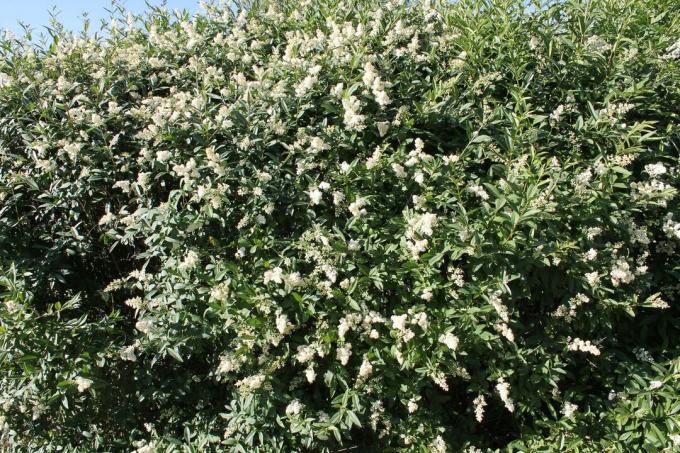Privet hedges protect against prying eyes. We show when, how and with what to fertilize your privet properly so that it grows bushy and dense.

the liguster (Ligustrum) is popular as a hedge plant or as a topiary because it is robust, green even in winter and wonderfully tolerant of pruning. The semi-evergreen shrub thrives in loose, humus-rich soil without additional fertilization. But if you want to promote healthy and strong budding, you should regularly add nutrients, especially nitrogen, to the soil. This is especially important if you are planting a privet hedge. Because the plants not only compete with each other for nutrients, but also with the adjacent greenery. The pruning also costs the plants a lot of energy and is much better tolerated if the fertilization is right. The plants sprout stronger and quickly form many new leaves.
As a hedge, plants are very dense and therefore have little privacy in the root area. Therefore, disputes about the nutrients available in the soil quickly arise. Especially when your hedge borders a lawn, the plants quickly compete for nutrients. You should therefore provide your privet hedge with these at least once a year. This ensures healthy and fast growth and prevents the formation of brown spots in the surrounding lawn. We will inform you about the right time to fertilize and help you to choose the most suitable fertilizer.
contents
- Privet hedge: When is the best time to fertilize?
-
Privet hedge: how and with what to fertilize?
- Fertilize privet organically
- Fertilize privet with minerals
- Fertilize privet with compost, horn shavings and the like
- Fertilize the privet in the pot
Privet hedge: When is the best time to fertilize?
If privets are planted on poor, depleted soil, plant fertilization should not be missing. For that, you should use well-ripened soil compost mix in In this way, your privet will be well cared for right from the start and will grow faster. This also applies if you use bare-root plant material instead of root ball material.

Whether you fertilize your privet hedge once or twice a year in the following years depends on the fertilizer choice. If you use a slow-release fertiliser, basic fertilization in the spring before the first sprouting in March/April is sufficient. Mineral fertilizer variants are usually immediately and briefly available in the soil for the plant. So that these nutrients can be used to the maximum extent by your privet hedge, it is fertilized twice a year - corresponding to the two growth spurts. Fertilization takes place at the end of April and beginning of August, always a few weeks before these periods, because this is when root growth begins. In this way, the given nutrients are absorbed most effectively by the plant. The pruning at the end of February and in autumn is also based on this budding cycle. Therefore, you can use it as a guide when fertilizing. If the fertilization takes place shortly before or after the pruning, the plants can recover better from the stress of the pruning and grow back faster.
At the end of August you should give the plants an autumn fertilizer with a potash fertilizer treat. The potassium helps harden newly formed shoots, making the plant less susceptible to frost damage.
Privet hedge: how and with what to fertilize?
Privet hedges can be wonderfully supplied with fertilizers for conifers or evergreen plants. They are not particularly demanding when it comes to the composition of their diet, but they do require a high proportion of nitrogen. This is important for the development of shoots and leaves. Especially fast-growing plants like privet need a good amount of it. Otherwise, it will take time for the plants to form opaque hedges. Becomes a mineral fertilizer used, the fertilization times must be meticulously adjusted to the growth rhythm of the plants.
It's easier to use one organic long-term fertilizer, because this is only applied once a year in spring before the first budding. With an organic fertilizer, however, it is not just the choice of when to fertilize that is easier. Mostly organic fertilizers like ours Plantura organic universal fertilizer are produced with significantly less resources than the mineral variants. Nevertheless, they offer a sufficiently high proportion of nitrogen. In addition, the groundwater is less polluted because the nutrients are stored in the soil and are not washed out with the irrigation water.

In terms of soil pH, privet plants are very tolerant. They grow in soil with a pH between 5 and 7.5, but prefer it a little more alkaline than acidic. If necessary, adjust the soil pH value by adding lime in the fall. This is recommended for sandy soils with a value below 6 and loamy soils with a value below 6.5. Simply mix crushed eggshells into the soil.
Fertilize privet organically
In organic fertilizers, the nutrients are in complex form. They are therefore stored in the soil and slowly decomposed over time by microorganisms in the soil. Only in this way are the nutrients released and available to the plant. On the one hand, this means that your choice of fertilizer supports healthy soil life, as happy earthworms ensure a loose and air-permeable soil. This in turn benefits your hedge, because privet are very sensitive to waterlogging. On the other hand, over-fertilization can be almost completely ruled out.
Just leave fallen leaves under the hedge. The mulch layer serves as an additional supply of magnesium and phosphate for the plants during decomposition. It also serves as ideal protection for the root area and small animals from the cold temperatures of winter. In addition, the mulch layer offers protection against drying out and also against annoying weeds. Besides, who likes to rake leaves? Alternatively, you can also use bark mulch, lawn clippings, cutting waste or similar as a mulch layer. However, never use mulching as the basic care for your privet hedge. Because this offers too little nitrogen. In addition, the microorganisms that break down the mulch also remove this important nutrient from the soil.
Fertilize privet organically: instructions
Despite the low risk of over-fertilization, correct dosing and application is also important with organic long-term fertilizers in order to make the nutrient uptake effective and beneficial. That's why we've put together a brief overview of the application of our Plantura for you below Organic universal fertilizer collected. This consists almost exclusively of organic components in organic quality and thus protects the environment and plants.

- Before planting 100 - 150 g/m² (well filled 0.2 liter glass) of ours Plantura organic universal fertilizer work into the top layer of soil
- Water the soil and freshly planted privet hedge well so that the granulate can be easily loosened
- For maintenance fertilization in spring, you should fertilize another 80 - 120 g/m² (0.2 liter jar) per plant
Fertilize privet with minerals
With most mineral fertilizer variants, the nutrients are available to the plant immediately and only for a short time. Therefore become blue grain and Co. adapted to the growth cycle twice a year. This allows the plants to use the nutrients to the maximum extent. Work blue grain or other mineral fertilizer in granular form superficially into the soil and then water vigorously. Otherwise, the nutrients cannot be absorbed or even burns can occur in the root area, because these fertilizers are highly concentrated. Therefore, you should also pay attention to the dosage recommendations on the fertilizers. Otherwise, you run the risk of over-fertilizing your privet. Otherwise, instead of a lush green hedge, an unsightly brown appears. A gentler method offers the combination of mineral fertilizer and compost. This reduces the risk of over-fertilization and at least some of the nutrients are gently released into the soil over the long term.
To ensure that your privet hedge survives the winter well, you can also fertilize with patent potash in the fall. This mineral fertilizer supplies your plants with potassium. This ensures that newly formed shoots lignify before the frost. The fertilizer also contains magnesium, which is particularly important for evergreen plants: it supports the formation of chlorophyll, the green leaf pigment. But magnesium is not only important for the optics. Autumn fertilization makes the plants more resistant to diseases and pests. You should apply about 40 grams of patent potash per square meter. In general, however, we recommend fertilizing with organic long-term fertilizers.
Fertilize privet with compost, horn shavings and the like
Since privets do not have extreme demands on their nutrient supply, fertilizing with a mixture once a year is sufficient compost and horn shavings. Make sure, however, that you only use well-ripened compost, as the decomposition process - as with mulching - removes nitrogen from the soil through microorganisms. Since the nitrogen content is not high enough even in mature compost, horn shavings should be added. These are real nitrogen bombs and thus support the growth of shoots and leaves in your privet. Three liters of mature compost are mixed with 100 grams of horn shavings per square meter. The mixture is worked into the upper layer of soil in the root area. Then spread a thin layer of soil over the fertilized area. This supports the decomposition of the organic material and thus the nutrient release.

Fertilize the privet in the pot
Species that are not hardy, mostly ornamental species from Japan or China, are often cultivated in tubs. Due to the small volume of soil, regular fertilization is recommended here. You should do this every two to three weeks from March to the end of August liquid fertilizer fertilize in the irrigation water. Alternatively, compost and horn shavings can be used as fertilizer in the spring. However, since the deployment is somewhat difficult, this variant is only recommended if you are repotting your privet. Long-term fertilizers in granular form like ours offer a good alternative Plantura organic universal fertilizer.



